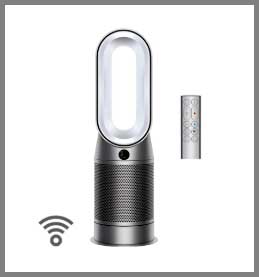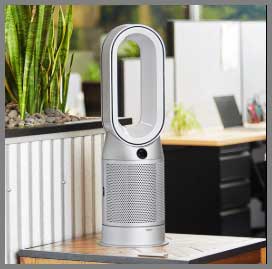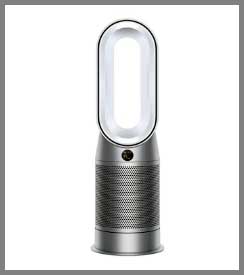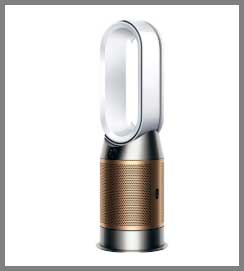If you’re staring at the Dyson shelves (or website), the HP07 and HP09 look identical. They both promise to heat, cool, and purify. So, what’s the catch? I’ve been analyzing these two machines, and the difference boils down to one specific, invisible threat: formaldehyde. My goal here is to help you decide if that one major upgrade in the HP09 is truly worth your money, or if the HP07 is all the high-tech purifier you’ll ever need.
A Brief Comparison Table
| Feature | Dyson Purifier Hot+Cool HP07 | Dyson Purifier Hot+Cool Formaldehyde HP09 |
| Primary Function | 3-in-1: Purifier, Heater, Cooling Fan | 3-in-1: Purifier, Heater, Cooling Fan |
| HEPA Filtration | Yes (HEPA H13) | Yes (HEPA H13) |
| Carbon Filter | Yes (Activated Carbon) | Yes (Activated Carbon) |
| Formaldehyde (HCHO) Sensor | No (detects general VOCs) | Yes (Solid-state, specific sensor) |
| Formaldehyde Destruction | No (Captures in carbon filter) | Yes (Selective Catalytic Oxidisation filter) |
| Lifetime Formaldehyde Filter | No | Yes |
| Particle Sensor (PM2.5, PM10) | Yes | Yes |
| VOC Sensor | Yes (General) | Yes (General) |
| NO2 Sensor | Yes | Yes |
| Oscillation | 350 degrees | 350 degrees |
| App Connectivity (Dyson Link) | Yes | Yes |
| Voice Control | Yes (Alexa, Siri, Google) | Yes (Alexa, Siri, Google) |
| Modes | Auto, Night, Backward Airflow | Auto, Night, Backward Airflow |
My Experience With The Dyson HP07 And HP09

Let me start by saying that unboxing either of these machines feels like a premium experience.
They are sleek, futuristic, and surprisingly lightweight.
The setup for both the HP07 and HP09 was identically simple: plug it in, download the Dyson Link app, and follow the on-screen prompts to connect to Wi-Fi.
In less than five minutes, I had full control of the machine from my phone.
My first test was the heating. I put one in my home office, which is notoriously chilly in the mornings. The HP07 and HP09 both brought the room to a comfortable 70°F (21°C) in about 15 minutes. The “Jet Focus” mode is brilliant, sending a direct stream of warm air right at my feet. The “Diffused” mode is better for heating the whole space evenly, which it does incredibly well thanks to the 350-degree oscillation.
Next, the “cooling” function. This is where I have to be a real user and manage expectations. This is not an air conditioner.1 It is a powerful, high-velocity fan.2 It does not lower the ambient temperature of the room. It cools you by creating a wind-chill effect. On a hot day, it’s a lifesaver, but it won’t replace a dedicated A/C unit in a heatwave. Again, in this respect, the HP07 and HP09 felt exactly the same.
The real difference became apparent when I started analyzing the air quality graphs in the app.
With the HP07, I loved watching the “Auto” mode work. I’d start cooking dinner, and the VOC (Volatile Organic Compounds) graph would spike yellow, and the fan would instantly ramp up to tackle the cooking fumes. When pollen season hit, the PM2.5 (fine particles) graph would climb, and the HP07 would kick in. I could see it working, and I felt confident my air was clean.
Then, I switched to the HP09. For the first few days, the experience was identical. The PM2.5 and VOC graphs behaved the same way. But then, I unboxed a new piece of flat-pack furniture. Within minutes, the HP09’s app showed a new, specific graph spiking into the red: HCHO (Formaldehyde). The HP07 would have just registered this as a general “VOC” spike. The HP09, however, specifically identified it. I watched as the machine ramped up, and over the next hour, that HCHO line dropped back down to green.
This was the “aha!” moment. The HP07 captures formaldehyde in its carbon filter, but the HP09 identifies it and destroys it.3 The HP09 has a dedicated, solid-state sensor that isn’t fooled by other VOCs, and its catalytic filter breaks the formaldehyde down into tiny, harmless amounts of water and CO2. And that catalytic filter never needs replacing.
For me, the experience was about data and peace of mind. The HP07 made me feel my air was clean. The HP09 proved it, even against specific, nasty chemicals I didn’t know were there.
Read more: My Thoughts on Demand CS Insecticide
Pros Of The Dyson HP07 (Purifier Hot+Cool)
- Exceptional Three-in-One Value: This is the core appeal. You are getting a year-round machine that replaces three separate, bulky appliances. In the winter, it’s a powerful and fast-acting space heater with a smart thermostat. In the summer, it’s an effective cooling fan. And all year long, it’s a top-tier air purifier. For someone in an apartment or a smaller home where storage space is at a premium, this consolidation is a massive win. You never have to put it in a closet; it’s always useful, adapting to the season.
- Powerful HEPA H13 Filtration: The HP07 is fully sealed to the HEPA H13 standard.4 This isn’t just a HEPA filter; it means the entire machine is sealed, so what goes in stays in. It captures 99.97% of particles as small as 0.3 microns. In real-world terms, this is the stuff that matters: dust mites, pet dander, pollen, mold spores, and even some bacteria. As an allergy sufferer, I found this feature alone to be transformative during spring. The machine’s “Auto” mode becomes your personal air guardian, ramping up the second it detects a rise in particulate matter.
- Robust Activated Carbon Filter: Beyond just particles, the HP07 has a substantial layer of activated carbon to tackle gases and odors. This is the feature you’ll notice most when you’re cooking. I’ve had it clear the smell of bacon or seared fish from my open-plan kitchen in under 30 minutes. It’s also fantastic at absorbing VOCs from cleaning products, smoke, or just that general “stale air” smell. It genuinely makes the air smell cleaner and fresher, which is a very tangible benefit.
- Fantastic Smart Features And App: The Dyson Link app is polished, intuitive, and data-rich. I love being able to check my home’s air quality from the office. I can see real-time graphs for PM2.5, PM10, VOCs, and NO2. I can set schedules, so the machine purifies and warms my bedroom 30 minutes before I wake up. The voice control (via Alexa, Siri, or Google) is also seamless.5 Just saying “Hey Siri, set the living room purifier to 70 degrees” feels futuristic and is incredibly convenient.
- Helpful And Unique Airflow Modes: The 350-degree oscillation is a huge feature, ensuring the entire room’s air is properly circulated and purified, not just one corner. But my favorite “hidden” feature is the Backward Airflow Mode. In winter, you want to purify the air, but you might not want a draft of hot or cool air blowing directly on you. This mode diffuses the air out of the back of the loop, so you get full purification without the draft. It’s an incredibly thoughtful design choice that I use all the time.
- More-Accessible Price Point: While no Dyson is “cheap,” the HP07 is significantly less expensive than the HP09. You are getting 95% of the functionality—the same heating, the same cooling, the same HEPA filtration, and the same smart app—for a noticeably lower price. If you don’t live in a brand-new-construction home or are not specifically worried about formaldehyde, the HP07 is unquestionably the smarter financial choice. It delivers the full premium Dyson experience without the niche chemical-zapping tax.
Cons Of The Dyson HP07 (Purifier Hot+Cool)

- It Is A Fan, Not An Air Conditioner: This is the single biggest misconception I see in user reviews, and it’s a critical con if you buy it for the wrong reason. The “Cool” in “Hot+Cool” refers to a cooling fan. It uses Dyson’s Air Multiplier technology to project a powerful, smooth stream of air.6 This creates a wind-chill effect that makes you feel cooler. It does not lower the actual ambient temperature of the room like an A/C unit that uses refrigerant. In a 90°F (32°C) room, it will blow 90°F air at you. It’s a fantastic fan, but it will not save you in a true heatwave.
- Noticeable Noise At High Speeds: Dyson’s marketing highlights its quiet operation, which is true… up to a point. On fan speeds 1 through 4 (which it uses for most low-level purification and night mode), it’s whisper-quiet. However, when it detects a major pollutant or you crank the fan to level 10 for maximum cooling, this machine gets loud. It sounds like a small jet engine. It’s fine for a quick “boost” to clear the air after cooking, but you cannot comfortably watch TV or hold a conversation with it running at full tilt.
- General VOC Sensor Only: This is the main functional difference. The HP07 has a sensor for “Volatile Organic Compounds,” which is a very broad category.7 This includes everything from perfume and aerosol sprays to cooking fumes and, yes, formaldehyde. The con is that it can’t differentiate between them. It might ramp up because you used hairspray, and you’ll have no way of knowing if your VOC spike is harmless or something more sinister like off-gassing from new furniture. It just lumps it all together.
- Formaldehyde Is Captured, Not Destroyed: Because it lacks the catalytic filter of the HP09, the HP07’s defense against formaldehyde is its activated carbon filter. This filter traps the HCHO molecules, which is good.8 However, over time, that filter can become saturated. When it’s full, it not only stops capturing new VOCs, but there is a theoretical possibility (known as off-gassing) that it could release some of those trapped compounds back into the air, especially in high heat or humidity. It doesn’t neutralize the threat; it just holds it prisoner.
- Ongoing Filter Replacement Cost: The high initial purchase price is only the beginning. The Dyson Combi filter (which includes both the HEPA and Carbon layers in one) needs to be replaced. The app will tell you when, based on usage, but Dyson generally recommends it every 12 months. These filters are not cheap. This is a significant, recurring cost of ownership that you must factor into your budget. If you don’t change the filter, the machine’s purification ability plummets and it just becomes a very expensive fan-heater.
Pros Of The Dyson HP09 (Purifier Hot+Cool Formaldehyde)

- The Gold Standard In Formaldehyde Destruction: This is the HP09’s entire reason for existing, and it’s a massive pro. It doesn’t just capture formaldehyde; it destroys it.9 The machine uses a Selective Catalytic Oxidisation (SCO) filter that has a unique coating. This coating chemically traps and then breaks down HCHO molecules into microscopic amounts of water and carbon dioxide. It is a permanent, chemical solution to a specific and dangerous indoor pollutant. This technology is a significant step above simple carbon filtration.
- Lifetime Catalytic Filter: This is a huge, value-adding feature. The SCO filter—the special formaldehyde-destroying part—is designed to last the entire life of the machine. It never needs to be replaced. While you still have to replace the standard HEPA/Carbon Combi filter annually, the most advanced (and presumably most expensive) piece of technology in the machine is a one-time investment. This makes the high upfront cost of the HP09 much more palatable over the long term.
- Dedicated, Solid-State Formaldehyde Sensor: The HP09’s sensor is a technological marvel. Unlike gel-based sensors that can dry out and degrade over time, Dyson’s is solid-state, meaning it lasts as long as the machine. More importantly, it is specific. It is algorithmically tuned to only detect HCHO (formaldehyde), so it won’t be fooled by other VOCs. This means when the “HCHO” level on your app or screen spikes, you know for a fact that it’s formaldehyde, and you can watch the machine specifically target and eliminate it. This precision provides incredible peace of mind.
- Perfect For Specific At-Risk Environments: If you live in a new-build house, have recently renovated, or just bought new furniture, your home is likely off-gassing formaldehyde. This chemical is common in resins, glues, particleboard, laminate flooring, and even new carpets. The HP09 is tailor-made for these environments. It provides an active, constant defense against this specific carcinogen, making it an essential health device, not just a luxury. It’s also fantastic for anyone with a woodworking hobby or an attached garage.
- It Has All The Pros Of The HP07: This is crucial. By choosing the HP09, you lose nothing. You still get the identical, powerful heating element. You still get the identical, effective cooling fan. You still get the fully sealed HEPA H13 filtration for dust and pollen. You still get the robust carbon filter for cooking odors and other VOCs. You still get the brilliant Dyson Link app, 350-degree oscillation, and backward airflow mode. The HP09 is simply the HP07 plus the advanced formaldehyde package. It is the fully-loaded, top-of-the-line model with no compromises.
Cons Of The Dyson HP09 (Purifier Hot+Cool Formaldehyde)

- The Significant Price Premium: The most obvious con is the cost. The HP09 commands a substantial price jump over the HP07. You are paying a lot of extra money for, essentially, one added feature. This forces you to do a serious cost-benefit analysis. Is the possibility of formaldehyde in your specific home worth the hundreds of dollars in difference? For many, the answer will be no, making the HP09 feel like an unnecessary expense.
- Potentially Unnecessary For Many Homes: This feature might be overkill. If you live in an older, well-ventilated home, haven’t bought new furniture in years, and don’t have new carpets or flooring, your ambient formaldehyde levels are likely to be extremely low or non-existent. In this scenario, you’d be paying a premium for a feature that is constantly idle. The HP07’s standard carbon filter would be more than sufficient to handle the occasional VOCs from cleaning or cooking. The HP09 solves a problem you may not actually have.
- Identical Physical Performance: If your main reason for buying a Dyson is for the heating or cooling fan, save your money and get the HP07. The HP09 uses the exact same heating element and the exact same Air Multiplier fan technology. It will not heat your room any faster. It will not blow any more air. It will not make you feel any cooler in the summer. All the physical, tangible performance metrics are identical. The extra cost is purely for an invisible, chemical-targeting feature.
- Still Requires The Other Filter: Don’t let the “lifetime filter” marketing confuse you. The catalytic formaldehyde filter is lifetime, but the HEPA H13 and Activated Carbon Combi filter is not. You still have to pay for and replace this main filter approximately every 12 months, just like with the HP07. The primary running cost of the machine is identical. The HP09 does not save you money on annual maintenance.
- The Same Noise Profile: Just like the HP07, this machine is loud at its highest settings.10 The addition of the catalytic filter does nothing to dampen the sound of the fan motor. When you crank it to level 10, it roars. If you were hoping the more-expensive model would also be quieter, you will be disappointed. It shares the exact same acoustic “con” as its cheaper sibling, which can be disruptive in a quiet living room or bedroom.
Maintenance Tips For The Dyson HP07 And HP09
- Wipe Down The Loop And Body: These machines are beautiful, but their matte finish can be a dust magnet. To keep them looking new and working efficiently, you should regularly wipe down the exterior with a dry or slightly damp microfiber cloth. Pay special attention to the inside of the “loop” amplifier, as dust can collect there. Never use harsh detergents or polishing agents, as they can ruin the finish. This also prevents dust from being recirculated.
- Gently Vacuum The Sensor Ports: This is a crucial step for maintaining “Auto” mode accuracy. On the side of the machine, there’s a small grille covering the particle and gas sensors. These tiny inlets can get clogged with dust, which “blinds” the machine. Dyson recommends gently vacuuming this area with a soft brush attachment once a month. If you notice your purifier isn’t reacting to cooking smoke or pollen like it used to, a clogged sensor is the most likely culprit.
- Replace The Combi Filter When Notified: This is the most important maintenance task. Your Dyson Link app and the machine’s LCD screen will give you a clear, unmissable alert when the filter life is low. Do not ignore this. A clogged filter severely restricts airflow, making the fan motor work harder (using more electricity) and dramatically reducing its ability to purify the air or heat/cool effectively. The replacement process is tool-free and takes about 60 seconds. You just pop the side covers, lift the old filter out, and drop the new one in.
- Clean The Filter Covers/Shrouds: When you pop off the outer covers to replace the filter, you’ll likely see a lot of larger dust and hair particles clinging to the outside of the filter covers (the part with the small holes). This is the machine’s “pre-filter.” Before you put the covers back on with your new filter, take them aside and vacuum them thoroughly with a brush attachment or wipe them down. This ensures maximum airflow for the new filter.
- Inspect The HP09’s Catalytic Filter: For HP09 owners only. When you have the main Combi filter removed, you will see the green-ish catalytic filter underneath, permanently fixed to the machine. You never replace this, and you must never wash it. However, it’s good practice to give it a quick visual inspection. Make sure it’s seated properly and hasn’t been damaged. You can gently vacuum any dust off its housing, but do not touch the filter medium itself.
- Keep The Remote In Its Spot: This is more of a user tip, but it’s vital. The small, curved remote is magnetic and designed to rest perfectly on the top of the loop. Get in the habit of always putting it back there. It’s small, black (or silver), and incredibly easy to lose in couch cushions. If you lose the remote, you lose access to some functions (like oscillation control) that aren’t available on the machine itself (though they are all in the app).
Also read: My Thoughts on Land Guard Raised Bed
Comparison With Other Brands
- Shark (e.g., 3-in-1 Models): Shark is Dyson’s most direct competitor in the “all-in-one” space. Their “Hot & Cold Purifier” models also offer heating, cooling, and HEPA filtration. The main difference is usually in the smart features and design. Shark’s “Clean Sense IQ” is similar to Dyson’s “Auto” mode, but the app and data readouts are generally less detailed and polished than the Dyson Link ecosystem. Shark often wins on price, offering very similar functionality for less, but Dyson wins on design, oscillation range (Shark is often more limited), and the sheer depth of its air quality data.
- LG (PuriCare AeroTower): If your primary concern is design, the LG AeroTower is a strong contender. It’s a beautiful, sculptural fan-purifier that often includes UVnano technology, which uses UV light to kill bacteria on the fan blades. However, many of LG’s models are cool-only or have a much weaker heating function than the Dyson. Their purification is excellent, but the core Dyson “Hot+Cool” promise is often stronger and more effective, especially for heating a room quickly. The AeroTower is often a quieter machine, though.
- Blueair (e.g., HealthProtect): If you are a purification-first, “prosumer” user, Blueair is a brand you must consider. Blueair machines are not all-in-one. They don’t heat, and they don’t cool (they are just purifiers). But they are arguably better at purification. Their “HEPASilent” technology often moves a massive amount of air (a higher CADR, or Clean Air Delivery Rate) much more quietly than a Dyson. You are trading the all-in-one convenience and sleek design for raw, quiet, purification power. If you already have a heater and fan you love, a dedicated Blueair purifier might be a smarter choice.
- Coway (Airmega): Coway is the powerhouse of the purification-only world. Their Airmega line (like the 400S) is known for being incredibly effective, smart, and robust. These are large, boxy machines that are designed to clean huge spaces efficiently. They often feature dual HEPA filters and extremely sensitive auto modes. You are making a huge trade-off in aesthetics—a Coway is a visible appliance, not a piece of art—but you are getting uncompromising air-cleaning performance. They have no heating or cooling functions, so they are not a direct Dyson competitor in that sense.
- The “Separate Appliances” Approach: This is the budget-friendly “common sense” alternative. For the price of one Dyson HP07, you could easily buy a top-rated, dedicated Levoit HEPA purifier, a powerful Vornado space heater, and a separate tower fan. The “pros” of this approach are massive: you get three best-in-class appliances for less money, and if one breaks, you don’t lose all three functions. The “con” is a lack of elegance. This means three plugs, three floor footprints, three remotes, and zero smart-app integration to control them all from one place. You are paying Dyson for the convenience, design, and smarts of consolidating all three.
Frequently Asked Questions (FAQ)
The “HP7A” or “HP7A Autoreact” is a variant of the HP07 that typically lacks Wi-Fi connectivity and Dyson Link app support. The main difference with the HP09 remains the same: the HP09 has the dedicated formaldehyde sensor and the catalytic filter to destroy it, while the HP7A does not.
The AM09 is an older “Hot+Cool” model, but it is not an air purifier. It has no HEPA filter. It is only a fan and a heater. If you only need heating and cooling, it’s a stylish choice, but it offers no air purification benefits.
The “HP10” is often the “Purifier Hot+Cool Gen 1.” It is a newer, sometimes more basic model that, like the HP07, includes HEPA filtration, heating, and cooling, but it lacks the specific formaldehyde sensor and catalytic filter found in the HP09.11 The HP09 remains the superior model for formaldehyde destruction.
Neither of these are air purifiers. The AM07 is a “Cool” tower fan only.12 The AM09 is a “Hot+Cool” fan and heater.13 The key difference is that the AM09 provides heat, and the AM07 does not.14
Conclusion: For The Dyson HP07 And HP09
So, after all that analysis, which one should you buy? My experience with both machines makes the decision crystal clear, and it all comes down to a single question you have to ask yourself: How much do you worry about formaldehyde?
These two machines are identical in heating, identical in cooling, identical in smart features, and identical in their HEPA filtration of dust and pollen. The Dyson HP07 is an outstanding, premium, all-in-one machine that will brilliantly heat, cool, and purify a room, and it’s the one I’d recommend to most people. If you just want to tackle allergies, cooking odors, and general dust, the HP07 is the smart, high-value choice.
However, you should buy the Dyson HP09 if you fall into a specific category. If you have just renovated, live in a new-build home, have new laminate floors, or are bringing new (especially flat-pack) furniture into your house, the HP09 is your machine. The peace of mind that comes from knowing you are actively identifying and destroying a specific carcinogen, rather than just trapping it, is worth the price premium.
You really can’t make a bad choice here; you’re getting a top-tier device either way. You just need to decide if your goal is “excellent” air purification (HP07) or “absolute” chemical-specific peace of mind (HP09).
